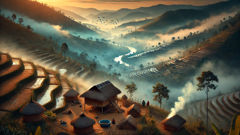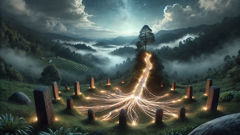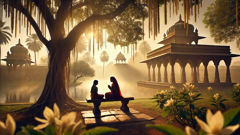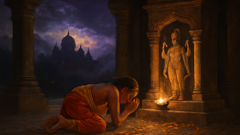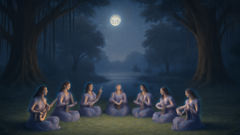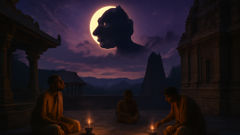Introduction
Beneath the steep, green ribs of the hills that cradle Manipur, where rivers unspool like silver thread through valleys, the Naga peoples trace the first breath of the world to the hush between two heartbeats. In these stories, mountains are elders and lakes keepers of memory; winds carry the names of ancestors and the stones remember every footstep. Night in the hills arrives like a shawl, embroidered with starlight, and with it come storytellers who sit with children and elders alike, their voices shaping the shape of things: how the first fire was born from a quarrel between two kinsmen of the sky, how spirits taught the people the tongues of birds, how the river learned to sing and how a warrior learned that courage can be both blade and mercy. This is a gathering of those tales—creation myths braided with accounts of spirit-guardians who walk the forests, and sagas of warrior heroes whose deeds were sung at harvest and festival. The purpose here is neither to flatten the living cultures into museum pieces nor to pretend to exhaust their complexity, but to offer an attentive retelling—rooted in place and season, receptive to detail, and respectful of the traditions that continue to shape identities across Manipur and the wider Northeast. Read these stories as you would a woven cloth: note the bright threads, follow the patterns, and hold them up to the light to see how they shift. The hills will still be there afterwards, and the rivers will continue to know their names.
Of First Breath and Stone: Creation Tales of the Naga Hills
In the beginning, it is said that there was a great silence that could not sleep. Out of that hush rose two siblings—Sky-Brother and Earth-Sister—whose disagreement gave the world its first motion. Some tellings say the siblings were beings of wind and mist, others that they were spirits shaped like deer. Whatever their form, their quarrel released sparks and seeds: a single spark became the first fire, a seed split open into the first tree, and from their footsteps the contours of the valleys and the courses of rivers were traced. The people of the Naga hills speak of this not as a single fixed episode but as a weaving of many small genesis moments. Each clan has a preferred image—one clan names the river as the child of Sky-Brother's teardrop, another says the lake took shape when Earth-Sister cupped her palms and carried the heavens' reflection as a living bowl.
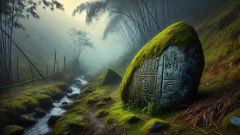
These myths do more than explain origins; they describe a relationship. Stones are not inert in these tales; they are the grandparents who hold knowledge of weather and time. One tale tells of a young hunter who lost his way on a misty ridge. He slept against a boulder and dreamed of a woman wrapped in moonlight. When he awoke, the boulder had shifted, revealing a small pool of clear water and a carved mark—an old clan symbol. The hunter took the water and returned home. That night his people dreamt as one: the boulder had spoken with the voice of an ancestor, reminding them of forgotten rites and the paths that must be walked to keep the valley fruitful. From that night the clan learned new songs to sing when planting, and they paid the stone with offerings of rice and tobacco. The stories insist that reciprocity defines humanity's place: gifts are given, and responses are expected. The land gives; humans give back in the form of care and remembrance.
Spirits, in Naga tales, are not faraway gods. They are neighbors. The forest holds many of them—small guardians of the bamboo groves that hum like strings, old women who have become cairns at trail intersections, fox-folk who trade riddles with travelers. In some accounts, the spirits are teachers: when hunters trespass without asking permission, a spirit may mislead them until they learn humility. When a family rebuilds a home after fire, they consult the household spirit and recite a litany of names for protection; if they fail, sickness becomes the uninvited guest. Rites of naming and of listening are central: before cutting a tree, the woodcutter whispers the tree's lineage and asks it forgiveness; before fishing, elders sing to the river, asking it to spare certain spawning pools for the next moons. These practices carry a pragmatic sapience: a people who ask permission are more likely to sustain resources for future generations.
The cosmology also provides room for transformations. Many tales feature shape-shifters and boundary-crossers—humans who marry a river-woman, spirits who take the form of birds. A repeated motif is the tunnel or cave that acts as an axis mundi: one enters, and daylight becomes dreamtime. In one well-loved account, a young weaver follows a song into a hollow and finds a subterranean market where ancestral weavers trade colors and patterns. She is taught a cloth-design, a patchwork that will later become a clan emblem. She returns with fingers stained in indigo and with a pattern that warns of approaching droughts when woven in a certain way. Such stories articulate knowledge: colors, patterns, and designs in textiles sometimes encode ecological knowledge—where to plant yams, when a dry season may linger, which trees yield edible shoots. Oral literature, then, doubles as a practical manual for surviving and flourishing in a landscape that can be both generous and austere.
Across the valleys and ridgelines the Naga myths emphasize continuity: what happened then and there informs what happens now. The ceremonies that accompany sowing, harvest, weddings and funerals are all threaded into the same narrative cloth. Festivals are living retellings—songs become recitations of origin, dances embody the steps of ancestral beings, and feasts replay the hospitality that once steadied wandering spirits. In these acts of repetition stories are kept alive, and place itself remains animated. A child learning the story of how the first deer taught people to cook learns, simultaneously, how to honor the animal when it is killed and how to use every part of it. That ethic—of mindful use—underlies many of the creation narratives: origin stories are instruction manuals for responsible living as much as they are explanations of beginnings.
The creation tales also contain gentler, quieter lessons. In one river-story, a woman breaks her promise to a water-spirit and finds that her reflection will not return her smile for three seasons; she learns how trust once broken reshapes relationships. In a mountain tale, a warrior who forged his fame through conquest is taught patience by an old herbalist spirit who shows him the slow growth of medicinal roots; only then does he understand that strength without knowledge can be brittle. These narratives teach balance—for a people who have survived for generations in the interstices of hills and floodplain, survival requires an attunement to cycles. The myths make space for grief and for repair: there is always a ritual to mend a rupture between human and spirit, a way to apologize and to restore harmony. The elasticity of these stories—their ability to hold both danger and consolation—makes them durable.
Language matters here: many Naga tales are sung in tones that mimic the landscape. There are melodies for rain, for quebrantó wind, for leaves falling; the cadences of speech act as weather signals. The older storytellers are careful with words; they speak names aloud for the living but keep certain secret names for sacred rites. This discretion has helped ensure the survival of stories through time, allowing the tales to adapt and be guarded. The result is a cultural archive where songs, chants, designs and place-names form an interlocking set of cues. Those who learn them learn more than stories: they learn how to be part of a long-duration conversation with place.
In the next part of this retelling, the focus shifts from origins to deeds: the warrior heroes whose names are shouted at festivals, the women who outwitted hostiles with weaving and wit, the trickster spirits who turned the worst winters into stories that warmed the long nights. Those tales hold another lesson, one about leadership and the temper of power in a community that prizes both courage and care.
Heroes, Shields, and Songs: Warrior Sagas and Spirit-Keeping
If the creation tales teach how the world was made, the warrior sagas teach how to live with one another inside it. These stories honor those who defended homes and those who brokered peace, and they celebrate the forms of courage that held communities together. Unlike an epic that glorifies endless conquest, Naga warrior tales often end with an emphasis on restraint, reconciliation, or the conversion of violence into ritual. Heroism in these narratives is as much about returning the lost child, saving a granary, or outwitting a raiding party with cleverness as it is about ferocity in battle.
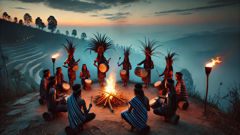
A common thread is the figure of the warrior who learns to see beyond his own fame. In one tale, a young man named Thonglen—whose name means "river-blood" in the retelling—becomes famed for his prowess with the spear. He brings safety to his hill-village, and songs spring up like mushrooms after rain. But Thonglen's pride becomes a burden; he refuses to heed the counsel of elders. One night a wandering spirit takes the form of a woman carrying a pot of boiling water and stands in Thonglen's path. She asks him a series of riddles; each one he answers with force and certainty. For the last riddle she asks him to carry her pot back to the valley. Thonglen, thinking this beneath him, refuses and walks around her. A flood arrives that season; the valley's paths are redrawn and many homes are damaged. Only when Thonglen humbly helps the woman—who is revealed as a guardian of the valley's irrigation—does the flood subside. He learns that leadership requires tending daily tasks as fiercely as one defends borders. Storytellers love this tale because it binds combative valor to the everyday work that sustains villages: a hero is both a shield and a hand that helps plant rice.
Women appear often as the unsung strategists in such narratives. One remembered story tells of a weaver named Inao who outwits a raiding band by weaving a cloth with the likenesses of the clan's ancestors sewn into its pattern. She spreads the cloth across a ridge at dusk; the raiders, seeing what they think are ancestral watchers, retreat for fear of ancestral wrath. Later, Inao negotiates a truce, offering to teach the raidsers to weave and share common orchards. In some versions the raiders accept and the two groups learn new songs and crafts together. Here bravery is intelligence and diplomacy as much as it is force.
There are also tales of boundary guardians—those who stand between the human and spirit worlds. One story speaks of a man called Sātam who kept watch at a footbridge said to be haunted. Travelers told of strange cries, and children refused to cross alone. Sātam would walk the bridge at dusk with a staff carved with clan sigils, his feet moving in the patterns of the old dances to call friendly spirits close and ward off malevolent ones. Those who saw him described lights moving in the mist, like eyes looking through netting. Sātam's real power was ritual knowledge: he knew the names to call and the songs to sing. The tale becomes a lesson that protective power often depends more on cultural knowledge than on weapons.
Even the instruments of war—shields, spears, woven armor—are animated in the stories. A famous shield, said to be made from bark and lacquered with pigments, is described in one saga as absorbing quarrels: once raised, it not only deflected spears but took in the anger of both sides, softening it into memory. After battle, the shield's scars were ritually cleansed and songs were sung into its grains so it would not carry bitterness forward. The idea is striking: objects inherit moral weight, and the community must care for the aftermath of conflict. Rituals of purification, the dances at harvest when weapons are laid aside and offered songs, become essential to social healing.
Songs themselves are crucial for preservation. Younger people learn clan histories through ballads that can be sung from dusk until dawn. The lyrics name ancestors, list migration routes, and record seasons of famine and plenty. In performing these songs, singers also demonstrate identity: a particular drum cadence or a woven pattern places a person within a network of relations. At festivals, dance becomes a public ledger. A step performed just so may mean an ancestor crossed a certain ridge; a hand gesture may indicate the village's original homestead. The performative aspect of these sagas thus functions as living archive; community memories that might otherwise erode in time are preserved through embodied practice.
Spirit-keeping is the other cornerstone of these narratives. Every village has thresholds and altars, and many stories are about maintaining those thresholds. If a shrine is neglected, stories warn, the protective spirits grow thin and misfortune slips in through small cracks—sickness, a bad harvest, quarrels. Rituals to honor the spirits can be modest: an offering of cooked rice placed on a rock, a little song called at dawn, the careful tying of a cloth to a tree to mark gratitude for a healed child. Larger ceremonies are public and musical, with drums, horns, and songs that call the entire valley to witness. In one celebrated tale, a community facing a prolonged drought organizes a procession to the highest ridge where elders tell the origin of the rain-spirit. The procession sings and lays small wreaths of millet; at the edge of dusk, a single cloud gathers, then another, and the sky opens enough to dampen the parched fields. Whether the rain arrives by meteorological happenstance or by spiritual intercession matters less than the fact that the community acted together.
These accounts often end with ethical notes. A hero's fame is measured not merely by the battles won but by the number of neighbors he protected and the humility he showed after glory. A warrior who hoards spoils invites trouble; a leader who listens invites longevity. The greatest heroes, the stories conclude, are those who become the soil under all feet—the people whose names are not loudly proclaimed but who are felt in the steadiness of daily life. In festivals and songs the names of such people are invoked not to glorify war but to teach how courage must be balanced with care.
Across both the creation tales and the warrior sagas we find a consistent concern: humans and spirits share the world, and the strength of a community depends on memory, ritual, and the willingness to remain attentive to place. The stories encourage a kind of stewardship—a practical, reverent, and communal way of being that has allowed the Naga peoples of Manipur and the surrounding hills to adapt and thrive across generations. They are living stories: told to protect, to teach, to call together, and to remember the fragile, enduring web of life.
In the final section, these narratives will meet the present: how songs and dances and patterns persist in contemporary life, how the younger generation negotiates tradition and change, and how the stories continue to shape identity in an era of shifting borders and new conversations.
Conclusion
The stories of the Nagas of Manipur are not relics locked in glass; they are living threads in the everyday fabric of valley and hill. They teach being and remembering: how to listen to stone, how to ask a river’s permission, how to marry courage to kindness. In song, in cloth, in the cadence of drums, those tales continue to hold communities together—shaping seasonal labor, ritual practice, and the ethics of relations between people and place. In recent years, younger generations have found new ways to carry these stories forward: recording elders’ songs, teaching children the old names, and weaving ancestral patterns into contemporary art. This is not a simple preservation; it is reimagining—stories adapting to radio and social media, festivals reaching new audiences, and the old lessons finding new applications in debates over land, conservation and belonging. Yet the heart of the matter remains the same: respect for boundaries, reciprocity with the world, and the careful tending of memory. If you leave these pages and walk a ridge in Manipur at dawn, you might hear an old refrain carried by the wind. Listen closely and you will find that the hills still answer, that the streams still keep count of seasons, and that the people who tell the tales continue to teach what the land itself cannot forget.

